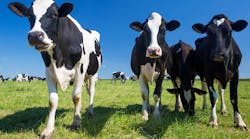Tyson Foods Inc. is raking it in on a tried-and-true staple: old-fashioned burgers and steaks made of actual beef.
The top U.S. meat producer made a notable exit from Beyond Meat Inc.’s shareholder register right before the start-up’s stellar initial public offering in May. Soon after, Tyson announced its own faux-meat products, which are starting to flow into retail stores. But the Springdale, Arkansas-based company posted record sales and beat earnings expectations in its third quarter largely because Americans are gobbling up beef.
The robust demand sent operating margins for the red meat to a record. Moreover, the hog-killing African swine fever that’s raging in China is set to boost all parts of Tyson’s operations in 2020, including chicken, pork, beef and prepared foods. Seeing all its units, which provide diversification for the company, improve in unison is a rarity, Chief Executive Officer Noel White said on a call with analysts.
China, the biggest pork consumer, is pulling protein from around the world to make up for the supply gap. The increased exports will probably start to materialize later in the year, White said, and the company has been in talks with Chinese buyers in recent months.
“All of the proteins will benefit,” White said on the call. “Somewhere around 5% of global protein has disappeared, so whether it’s a direct benefit or an indirect benefit, regardless, it will be beneficial to us.”
Admittedly, Tyson has yet to see any real boost from the disease, and its pork business was negatively impacted in the quarter, due to rising live hog costs. Volatility is rising as trade flows shift, and no one really knows when any business boosts from the disease will come.
But the company says it expects to see the positive impacts next year. U.S. domestic protein production will rise 2%, and Tyson said export markets will absorb it. The company’s operating margins for chickenーthe cheapest substitute for porkーwill improve over this year’s 6%, while beef and pork margins will be the same or better, it said.
Meanwhile, revenues are at a record for Tyson at almost $11 billion last quarter. There’s more cattle available in the U.S., and stronger demand for beef, which lifted prices for the red meat. The company’s prepared-foods segment also saw robust demand in the first nine months of the fiscal year.
Third-quarter adjusted earnings came in at $1.47 a share, exceeding the $1.44 average analyst estimate. A lower-than-expected tax rate helped, according to JPMorgan Chase & Co. On a net basis, earnings rose 25% from the same period last year and Tyson maintained its 2019 guidance.
Chicken may especially benefit from the swine fever. It’s the cheapest pork substitute, and the white meat is already starting to become more popular in the U.S.
Competitors like Pilgrim’s Pride Corp. said they’ve been benefiting from the trade tensions, with Mexico eating more chicken after importing less pork from the U.S. Demand is also starting to rise in the U.S. as fast-food restaurants promote the white meat and put more chicken sandwiches on menus.
Tyson’s shares were up 8.2% at 11:03 a.m., heading for the biggest gain since early 2016. The stock has surged more than 50% this year on expectations that swine fever will benefit the company overall, even though input costs for its prepared foods will increase.
The company said it expected to recover those costs through pricing, though there could be a lag as changes take effect. Live-hog costs already increased in the fiscal third quarter, and 2020 costs will be higher than in 2019, the company said.
Fiscal 2019 sales are expected to grow to $43 billion on bigger volumes and recent acquisitions, including Keystone Foods and the Thai and European operations from BRF SA. In 2020, those will grow as much as 7% to $46 billion.
By Lydia Mulvany




